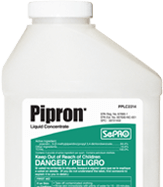Pipron®
The Industry Standard for Curative Powdery Mildew Control


Pipron Fungicide is another industry standard fungicide offered by SePRO. Pipron provides second-to-none curative powdery mildew control. As a highly effective contact fungicide, Pipron acts quickly to eradicate existing powdery mildew infections, leaving no visual residue. Pipron has been a utilized effectively for over 20 years with no evidence of resistance. For best results thoroughly apply Pipron to areas of new growth and areas already infected with powdery mildew.
It's as common on your plants as the soil around them. Powdery mildew. If conditions are right, it can go from one leaf to an epidemic in three or four days. It's always there, waiting for you to ignore it. Waiting to eat into your plants and profits. To keep that from happening, you must continually employ integrated disease control procedures against the spread and development of powdery mildew.
We hope to give you all the information you need to do just that.
The first sign of powdery mildew is very hard to detect: Yellow spotting on leaves or tiny blistering on the leaves or flowers, caused by yet unseen lesions forming rapidly. Left unchecked, white lesions start appearing all over the leaves, stems or flowers. Spores by the hundreds are produced on the white mycelium (the thread-like body of the fungus) growing over the tissue, giving the disease the look of white powder.
Any control measures you take should be aimed directly at the prevention of powdery mildew development. For starters, you have to control what foes on in yours plants' environment, especially the greenhouse. First and foremost, you must stop condensation from forming on plant leaves at the end of the day.
Cultural practices to help prevent powdery mildew in the greenhouse:
SePRO provides high-quality solutions for insect and disease control, as well as plant growth regulation to help you bring healthy, sellable plants and produce to your customers. See how we can help.